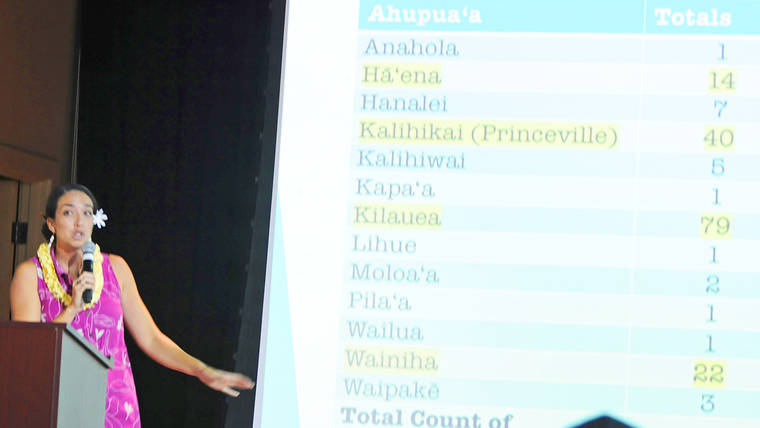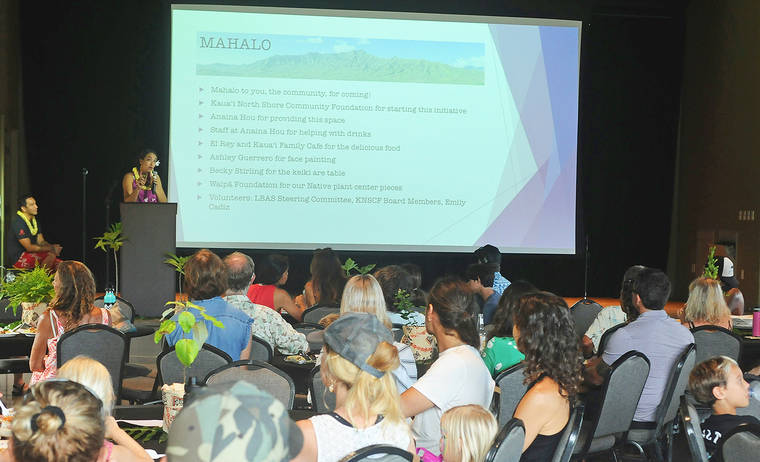‘Namahana’ gathering support


KILAUEA — On Saturday night before a capacity crowd at Anaina Hou’s Porter Pavilion in Kilauea, a North Shore community group announced the name of the public charter middle and high school it hopes to open in three to five years.
To be called Namahana —“the gathering place of the chiefs” — the school will serve as many as 350 students who currently must take long round-trip bus or rides to Kapaa for public middle and high school.
An eight-acre site has already been committed to the project on the Wai Koa Plantation site, and educational, engineering and fundraising consultants have been retained. A request for proposal is being prepared to identify an architect, according to the group, which is sponsored by the Kauai North Shore Community Foundation.
The education consultant, Big Picture Learning, is an international firm that assists schools in many parts of the world and all over the United States.
The organizing effort must ultimately raise several million dollars to get the project off the ground, but a series of five “listening sessions” held from Haena to Kilauea have identified what organizers believe is a strong core of potential support. The new school would include grades seven through 12 and have a public charter structure, meaning attendance would be free.
The sessions were organized after a petition circulated in 2015 gathered 600 signatures of people who support formation of a North Shore public charter school.
Interest in the new school was especially strong in Haena, Princeville, Kilauea and Wainiha, with slightly less involvement in Hanalei — possibly because that community has been losing permanent population for many years as its housing stock is increasingly taken up by vacation rental properties and homes occupied part time by absentee owners.
The public meeting at which the new findings were presented attracted more than 200 people, and received strong support from the crowd, which included Bill Arakaki, state Department of Education Kauai complex superintendent, who nodded approvingly to the presentation. But the majority of the crowd were young parents with their children in tow.
The school name was derived from the community listening process, which also produced a vision and mission for the schools to incorporate “place-based learning.”
According to Kapua Chandler, the Kilauea-based educator who led the community-outreach effort, that means that “learning is tied to what is local.” To learn about the history and culture of the Kalihiwai property where the school will be built, Chandler enlisted the help of her cousin, Hawaiian-language scholar and kumu hula Devin Kamealoha Forrest.
Going back to source material — including Hawaiian-language newspapers and other archival documents dating back to the early 1800s — Forrest looked beyond the later developments of the Kilauea Lighthouse and plantation to the indigenous Hawaiians.
“If you go back in time, you learn that the area around Namahana is where the chiefs and chiefesses gathered to have a merry old time,” he said.
Thus Namahana — the 2,700-foot-high mountain that stands vigil over Kilauea at the northeast portion of Kauai at the junction of the Moloaa, Halelea and Kealla forest reserves — also means “feeding.”
Chandler said the place name will inspire “all people to act in a chiefly way and be problem-solvers and not problem-makers. Just as Namahana feeds Kilauea, our school will feed our children and our community.”
“The need for a school like this has been voiced by the community for 30 years,” said Jen Luck, another of the organizing committee members and the mother of two children who might someday attend Namahana Schools. “This is really the first well-organized effort to start a tuition-free school.
“All of the signs have been incredibly positive.”
Laurie Mull, co-chair of the steering committee organizing the school, emphasized that the group is not trying to rush the process. The idea, Mull said, “is to get it right, but not (necessarily) get it now.”
“It’s expensive to plan a school, and to do it right takes dollars,” said Luck. “We have several years to do it.”
The group emphasized that, although the Wai Koa property owned by the late Bill Porter and his wife, Joan, is now for sale, that the school has an ironclad, 99-year lease to the eight-acre parcel on which the school might rise. No ownership change can affect that, said Melanie Parker, another of the organizers.
The group has not done projections of how many students might actually materialize from each community. To some extent, data from the still-unadministered 2020 census will be necessary to accomplish that goal. However, Chandler said it is assumed that the Kilauea and Hanalei (which draw pupils from the Hanalei-Haena corridor) elementary schools will be the primary feeders.
As the system works now, once children graduate from one of those two elementary schools, they must take a bus or be driven to Kapaa Middle School. For kids who live at the far end of the North Shore zone — Haena and Wainiha — that can mean a two-hour commute in each direction, sometimes on two different buses.
•••
Allan Parachini is a Kilauea resident, journalist, furniture-maker and retired public relations executive who writes periodically for The Garden Island.

That’s a good idea to have a school there to prevent that long exhausting bus ride to Kapa’a